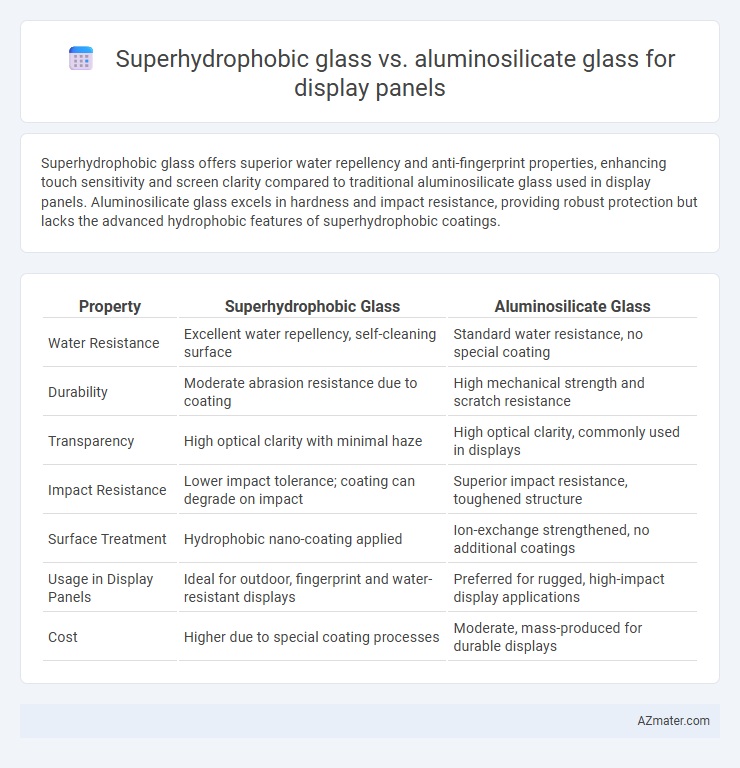Superhydrophobic glass offers superior water repellency and anti-fingerprint properties, enhancing touch sensitivity and screen clarity compared to traditional aluminosilicate glass used in display panels. Aluminosilicate glass excels in hardness and impact resistance, providing robust protection but lacks the advanced hydrophobic features of superhydrophobic coatings.
Table of Comparison
| Property | Superhydrophobic Glass | Aluminosilicate Glass |
|---|---|---|
| Water Resistance | Excellent water repellency, self-cleaning surface | Standard water resistance, no special coating |
| Durability | Moderate abrasion resistance due to coating | High mechanical strength and scratch resistance |
| Transparency | High optical clarity with minimal haze | High optical clarity, commonly used in displays |
| Impact Resistance | Lower impact tolerance; coating can degrade on impact | Superior impact resistance, toughened structure |
| Surface Treatment | Hydrophobic nano-coating applied | Ion-exchange strengthened, no additional coatings |
| Usage in Display Panels | Ideal for outdoor, fingerprint and water-resistant displays | Preferred for rugged, high-impact display applications |
| Cost | Higher due to special coating processes | Moderate, mass-produced for durable displays |
Introduction to Advanced Display Glass Technologies
Superhydrophobic glass features nanoscale surface textures coated with low-surface-energy materials, providing exceptional water repellency and self-cleaning properties that enhance display durability and visibility under wet conditions. Aluminosilicate glass, characterized by its high strength and chemical resistance due to its aluminum oxide and silica composition, offers superior scratch resistance and mechanical robustness critical for touchscreens and mobile devices. Advanced display glass technologies leverage these materials to optimize device longevity, user experience, and environmental resilience in modern electronic displays.
What is Superhydrophobic Glass?
Superhydrophobic glass features a nanoscale textured surface that repels water, preventing droplets from adhering and ensuring clear visibility even in wet conditions. Its unique water-repellent properties enhance display panel durability by reducing smudges, fingerprints, and corrosion compared to traditional glass types. In contrast, aluminosilicate glass is chemically strengthened for high impact resistance but lacks the inherent water-repellent capabilities found in superhydrophobic coatings.
Key Properties of Aluminosilicate Glass
Aluminosilicate glass offers superior mechanical strength and excellent scratch resistance compared to traditional superhydrophobic glass, making it ideal for durable display panels. Its high chemical durability and thermal stability ensure long-lasting performance under harsh environmental conditions, while maintaining optical clarity essential for touchscreens and high-resolution displays. These key properties position aluminosilicate glass as a preferred material in rugged and premium electronic device displays.
Surface Protection: Superhydrophobic vs Aluminosilicate
Superhydrophobic glass features a nanoscale surface texture combined with low surface energy coatings, providing superior water repellency and self-cleaning properties, which significantly reduce fingerprint smudges and environmental contaminants on display panels. Aluminosilicate glass offers exceptional chemical and mechanical strength due to its high aluminum and silicon oxide content, enhancing resistance to scratches, impacts, and thermal stress. While aluminosilicate glass primarily delivers robust physical protection, superhydrophobic coatings focus on surface cleanliness and moisture resistance, making their combination ideal for maximizing display panel durability and clarity.
Durability and Scratch Resistance Comparison
Superhydrophobic glass offers enhanced water and stain repellency but typically exhibits lower scratch resistance compared to aluminosilicate glass, which is renowned for its superior hardness and durability in display panels. Aluminosilicate glass, such as Corning Gorilla Glass, provides exceptional protection against mechanical wear and impact, making it the preferred choice for high-durability touchscreens. While superhydrophobic coatings improve surface cleanliness, they tend to be less robust under abrasion, resulting in decreased longevity compared to the inherently tough structure of aluminosilicate glass.
Optical Clarity and Display Performance
Superhydrophobic glass offers superior water and fingerprint repellency but may introduce minor surface texture variations impacting optical clarity, potentially reducing display sharpness and color accuracy compared to aluminosilicate glass. Aluminosilicate glass is engineered for high optical transparency and durability, maintaining excellent light transmittance and minimal distortion essential for vivid display performance. When prioritizing display quality, aluminosilicate glass typically ensures optimal visual clarity and consistent touchscreen responsiveness, whereas superhydrophobic coatings enhance surface protection with slight trade-offs in display crispness.
Water and Oil Repellency: Real-World Benefits
Superhydrophobic glass exhibits superior water and oil repellency compared to aluminosilicate glass, significantly enhancing display panel durability and cleanliness. Its nano-textured surface prevents water droplets and oily fingerprints from adhering, ensuring clearer visibility and reduced maintenance in outdoor and high-touch environments. Aluminosilicate glass, while strong and scratch-resistant, lacks these self-cleaning properties, making superhydrophobic glass a preferred choice for applications requiring high-performance water and oil resistance.
Application Suitability in Modern Displays
Superhydrophobic glass offers superior water repellency and self-cleaning properties, making it ideal for outdoor and rugged display panels exposed to harsh environmental conditions. Aluminosilicate glass provides exceptional mechanical strength, scratch resistance, and high thermal stability, making it suitable for high-performance touchscreens and smartphones requiring durability. For modern displays, aluminosilicate glass is preferred in devices demanding robust protection, while superhydrophobic coatings are increasingly integrated to enhance display longevity in wet or dirty environments.
Cost Efficiency and Manufacturing Considerations
Superhydrophobic glass enhances display panel durability and reduces cleaning frequency but involves higher material and coating process costs compared to aluminosilicate glass, which offers superior strength and scratch resistance at a lower price point. Aluminosilicate glass is widely favored in mass production due to its compatibility with existing manufacturing lines and lower thermal processing requirements, resulting in faster throughput and reduced energy consumption. Balancing cost efficiency, aluminosilicate glass remains the preferred choice for large-scale display panels, while superhydrophobic coatings are selectively applied for premium or specialized products requiring enhanced water repellency.
Future Trends in Display Panel Glass Materials
Superhydrophobic glass enhances display panels with superior water repellency and smudge resistance, improving durability and visibility in harsh environments. Aluminosilicate glass offers exceptional strength and scratch resistance, crucial for foldable and flexible displays, making it a preferred material in next-generation devices. Future trends emphasize hybrid coatings combining superhydrophobic properties with aluminosilicate substrates to achieve both mechanical robustness and self-cleaning functionality in advanced display panel glass materials.

Infographic: Superhydrophobic glass vs Aluminosilicate glass for Display panel
 azmater.com
azmater.com